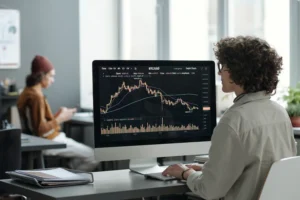Margin trading has become a game-changer for traders who want to unlock bigger opportunities in today’s dynamic markets. By using leverage, you can control larger positions than your actual investment—potentially multiplying your profits on every successful trade. However, margin trading is not just about boosting gains; it also means greater exposure to risk, making careful planning and risk management absolutely essential.
In 2025, the financial landscape is more volatile than ever. Global events, shifting interest rates, and evolving market trends can trigger wild price swings overnight. For traders, this environment offers both unmatched potential and new challenges. Whether you’re trading forex, stocks, or crypto, knowing how to manage margin safely could be the difference between growing your account or facing heavy losses.
This guide will walk you through the fundamentals of margin trading, explain how it works across different asset classes, and show you the best practices to protect your capital. You’ll learn about the benefits, the risks, the calculations behind margin requirements, and the strategies top traders use to stay profitable and safe. By mastering margin trading in 2025, you can approach the markets with more confidence, adapt to changing conditions, and position yourself for smarter, more consistent profits.
What Is Margin in Trading? Getting to Grips with the Core Concept
Margin trading lets you borrow money from your broker to open larger trades. The “margin” is your deposit, used as collateral. The broker lends you the rest. This makes it possible to trade more with less of your own money. Instead of paying the full price for an asset, you only pay a percentage. This is your margin requirement. The rest is provided by the broker.
Let’s say you want to buy $20,000 of shares but only have $2,000. If the broker sets a margin requirement of 10 percent, you can use your $2,000 to open the $20,000 trade. The broker covers the other $18,000. Your $2,000 is the margin in trading.
Every broker and asset class sets different margin rules. In forex, margin requirements can be as low as one percent. In stocks, they might be higher. Cryptocurrencies often allow high leverage, but with greater risk. Understanding what margin is in trading allows you to choose the best opportunities and avoid dangerous mistakes.
Margin trading is available across stocks, forex, commodities, and cryptocurrencies. This flexibility draws traders who want more options and more control over their capital. Yet, the process also introduces risk. With greater opportunity comes greater responsibility.
Leverage in Trading: The Power and the Risk
Leverage in trading is the heart of margin trading. It multiplies your potential returns and also your potential losses. Leverage refers to how many times greater your position size is compared to your margin. If you use ten-to-one leverage, every dollar you invest lets you control ten dollars in the market. Brokers set maximum leverage limits based on regulations and their own risk appetite.
Let’s explore a typical example. Priya wants to trade EUR/USD in the forex market. She has $1,000 and chooses twenty-to-one leverage in trading. She now controls a $20,000 position. If the currency pair rises one percent, Priya earns $200. That’s a twenty percent gain on her margin. But if the market moves against her by one percent, she loses $200. With higher leverage in trading, even small price moves can have a dramatic effect.
Leverage in trading is a double-edged sword. It gives you access to bigger opportunities but also means you can lose your margin very quickly. Many new traders underestimate this risk. Professional traders always respect the dangers of leverage and use it carefully.
Regulators have stepped in to set caps on leverage in trading for new traders. In the European Union and the UK, forex leverage is often limited to thirty to one. In the US, stock margin accounts usually offer two-to-one leverage. Crypto exchanges sometimes allow leverage as high as one hundred to one. Always check your broker’s terms before you trade.
Margin Trading Advantages and Disadvantages
Margin trading is not a guaranteed shortcut to riches. It offers some important advantages, but every benefit has a flip side. The key to long-term success is balancing the advantages and disadvantages.
The main advantage of margin trading is the ability to open bigger trades with less of your own money. This means your capital goes further. You can diversify across more markets, react faster to opportunities, and use advanced strategies like short selling. For active traders, margin trading can turn small moves into big profits.
However, the disadvantages are just as real. Losses grow just as fast as profits. If you make the wrong call, you can lose your margin very quickly. Borrowed funds are not free—brokers charge interest on the money you use. This cost can add up, especially for long-term trades. In volatile markets, margin trading can be especially risky. A single news event or sudden price swing can erase your margin in seconds.
Margin trading demands constant attention. You need to watch your account balance, track your open positions, and be ready to act at any time. If you are not careful, you can lose more than you deposit.
Let’s look at a case study. Raj uses margin trading to buy $10,000 in tech stocks with a $2,000 margin at five-to-one leverage. After disappointing earnings, the stock falls ten percent overnight. Raj’s loss is $1,000, half his margin. If the stock had dropped just twenty percent, his entire margin would be gone, and he would face a margin call, explained below.
Margin Call Explained: The Safety Net and the Risk
A margin call, explained simply, is a warning from your broker. If your account equity drops below a certain level, the broker asks you to add funds or reduce your positions. This level is called the maintenance margin. If you do not respond to a margin call, your broker can close your trades automatically.
Margin calls protect brokers from losing money on your trades. But they also protect you from losing more than you can afford. The margin call explained in practice is a crucial moment. You must act fast to avoid forced liquidation.
Example: Saira opens a gold trade with a $1,000 margin at ten-to-one leverage, controlling $10,000. Gold falls five percent. Saira loses $500, half her margin. Her broker sends a margin call explained in detail as a message on her platform. She must deposit more money, or her trade will close at a loss. Margin calls happen quickly in volatile markets, especially with high leverage.
To avoid margin calls, use stop-loss orders on every trade. Monitor your positions closely. Keep extra cash in your account as a buffer. Never risk all your capital at once. The best traders are always prepared for margin calls and have a clear plan.
Margin Trading in Action: How the Full Process Works
The process of margin trading starts with opening a margin account at your broker. You sign a margin agreement, deposit your funds, and choose your asset. The broker calculates the margin required based on the asset’s risk and your leverage settings.
Once your position is open, your broker monitors your equity in real time. As the market moves, your profits or losses are reflected in your account. If your margin drops too low, you get a margin call explained by the broker’s alert. If you do not add funds or close some trades, the broker may sell your assets to restore the balance.
Interest charges are added daily for the borrowed funds. This can eat into your profits if you hold positions for long periods. Make sure you know how much you are paying and factor it into your trading plan.
You can use margin trading to go long or short. If you expect a stock to rise, you buy on margin. If you expect it to fall, you can sell short—borrowing shares to sell now and buy back later at a lower price. This flexibility is one of the margin trading advantages.
Margin trading works across stocks, forex, commodities, and cryptocurrencies. Each market has its own rules for leverage, margin requirements, and liquidation. Learn the details for your market before you trade.
Real-World Examples: Margin Trading in 2025
Forex trading is the most common place for margin trading. Suppose you want to buy $100,000 of GBP/USD with a $2,000 margin at fifty-to-one leverage. If GBP/USD rises one percent, you earn $1,000—a fifty percent gain on your margin. But if it drops one percent, you lose $1,000 just as fast. Margin calls are common if the market moves against you.
In stocks, margin trading allows you to buy more shares than your cash balance. Vinay wants to buy $25,000 in pharma stocks but only has $5,000. With five-to-one leverage, he controls the whole position. If the stocks rally ten percent, Vinay gains $2,500, or half his margin. But if they fall ten percent, he loses the same amount. If his losses reach a certain level, his broker sends a margin call explained through a platform notification.
Crypto trading uses the highest leverage in trading. Anil opens a Bitcoin trade with a $500 margin at twenty-to-one leverage. If Bitcoin rises five percent, Anil makes $500, doubling his money. If it falls five percent, he loses his entire margin. The exchange liquidates his position if he cannot meet the margin call.
Strategies for Safer Margin Trading in 2025
Margin trading is not about luck. Smart strategies make all the difference. The most important thing is using stop-loss orders to limit losses. Set your stop-loss based on how much you can afford to lose, not on hope.
Diversification also reduces risk. Spread your margin across several assets or markets. If one trade fails, others can balance your results.
Track interest costs carefully. Borrowed funds cost money. Close losing trades early to avoid paying unnecessary interest. Only hold positions overnight or for weeks if you have a strong reason.
Use lower leverage in trading as you learn. Many new traders are tempted by high leverage, but pros know it is safer to start small and increase leverage slowly.
Practice margin trading with a demo account. Many brokers offer simulated trading with real market data. This lets you learn without risking real money.
Keep a detailed trading journal. Write down every trade, your reasons, your emotions, and your results. Review your journal often to spot mistakes and improve your process.
Margin Trading in Stocks, Forex, and Crypto
Every market has its own margin trading rules. Stockbrokers often limit leverage to protect investors. Regulations may require minimum account balances and regular risk disclosures. Interest rates on borrowed funds can vary widely.
Forex brokers offer higher leverage, sometimes up to one hundred to one. This is why margin trading is so popular in forex. But sharp moves in currency pairs can lead to rapid losses. Margin calls can come quickly and wipe out your margin if you are not ready.
Crypto exchanges are famous for extreme leverage in trading. Prices can swing ten percent in minutes. Liquidations happen automatically if your margin runs out. Always know your risk and use stop-loss orders.
The Psychological Challenge:
Margin trading is as much about psychology as it is about numbers. Large wins and losses can create emotional swings. Panic, greed, and regret are common. The best margin traders control their emotions and follow a strict plan.
After a loss, step back and review what happened. Do not chase losses with bigger trades. Focus on long-term growth, not fast riches. Taking breaks, talking to other traders, and regular self-assessment all help keep your mindset healthy.
Margin Call Explained in Depth
When a margin call happens, act fast. Check your open positions and decide whether to add funds or close trades. Never ignore a margin call explained by your broker’s message. The faster you respond, the more control you have over the outcome.
Sometimes, closing a losing trade is the smartest choice. Accepting a small loss is better than risking a forced liquidation and a bigger loss.
Regulations, Tools, and Technology in 2025
Margin trading has changed with new rules and better technology. Regulators now require brokers to display risks clearly and limit maximum leverage for new clients. Automated alerts, AI risk warnings, and instant notifications help you manage margin and avoid surprises.
Mobile trading apps allow you to watch your margin balance, set alerts, and respond to changes anywhere. Use all the technology at your disposal to protect your capital.
Real-Life Case Studies: Margin Trading Success and Failure
A seasoned forex trader, Mehul, uses margin trading to open positions on EUR/USD, GBP/JPY, and AUD/CAD. He keeps detailed stop-loss orders and watches news events. One trade moves against him, but his stop-loss prevents a big loss. The other trades profit. Mehul avoids a margin call and grows his account steadily.
A crypto beginner, Neha, opens a 50x leveraged trade on Ethereum. A sudden drop wipes out her margin in minutes. She receives a margin call explained in her app, but it is too late to act. The lesson is clear—always know your risk and never use more leverage than you can handle.
Final Thoughts:
Margin trading is a powerful tool, but it must be used with care. Understanding what margin is in trading, respecting leverage in trading, and knowing margin trading advantages and disadvantages are the foundation for long-term success.
Margin trading offers greater opportunities, flexibility, and potential rewards. Yet, the risks of rapid losses, margin calls, and emotional stress are real. Use stop-loss orders, monitor your trades closely, and always be prepared for a margin call explained by your broker.
Practice, patience, and discipline set great margin traders apart. With the right approach, margin trading can help you profit in 2025’s fast-moving markets—without risking more than you can afford to lose.
Read here to learn more about “Copy Trading Safe Way to Profit or Risky Mistake for New Traders“.

I’m Chaitali Sethi — a seasoned financial writer and strategist specializing in Forex trading, market behavior, and trader psychology. With a deep understanding of global markets and economic trends, I simplify complex financial concepts into clear, actionable insights that empower traders at every level. Whether it’s dissecting winning strategies, breaking down market sentiment, or helping traders build the right mindset, my content bridges the gap between information and implementation.

